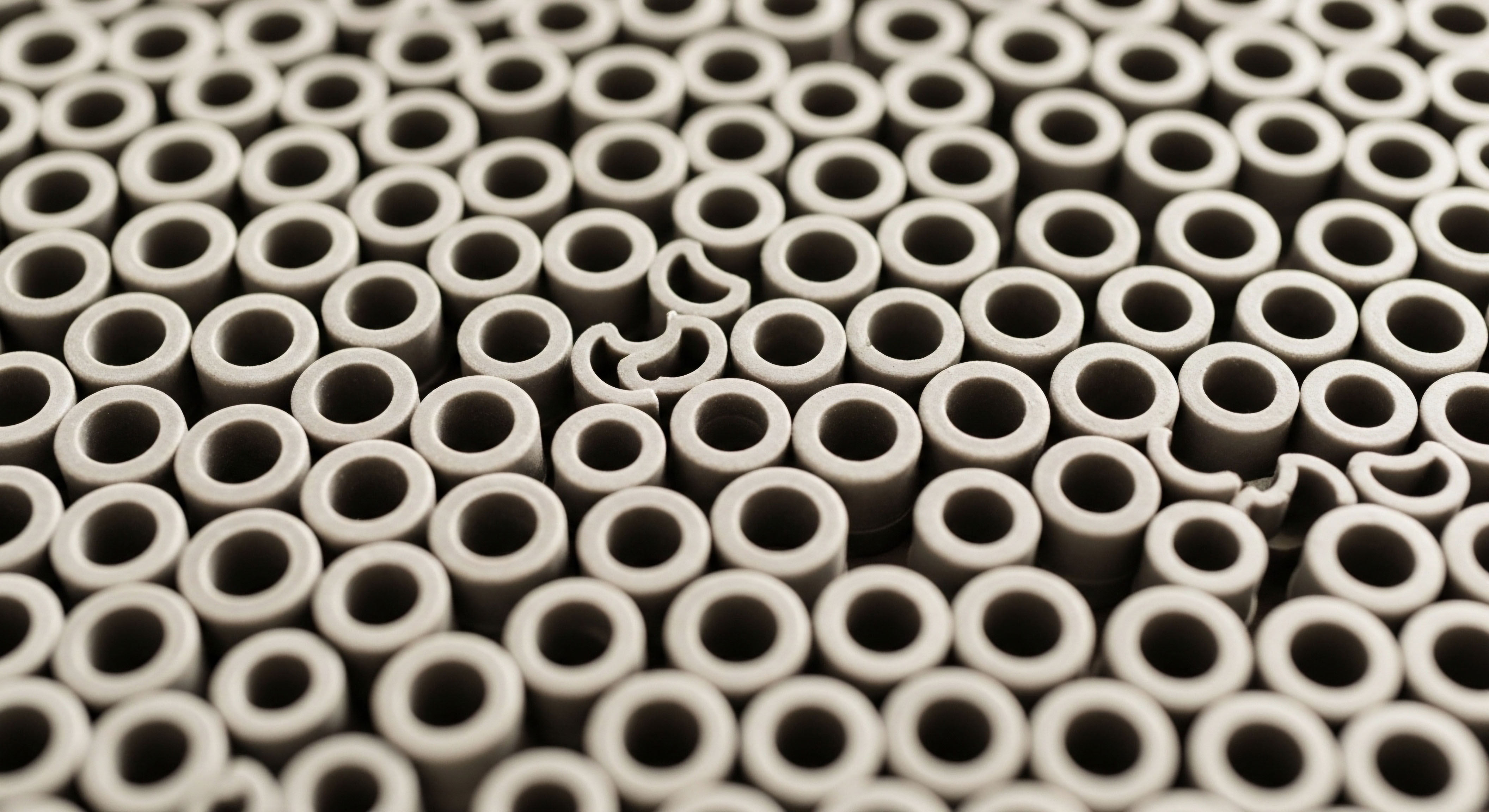

Fundamentals
You have arrived here because a disconnect has grown between how you feel and how you know you are capable of functioning. This experience, a subtle yet persistent erosion of vitality, focus, or strength, is not a matter of imagination. These feelings are data.
They are your body’s primary method of communicating a profound shift in its internal chemistry. When you seek out and begin a hormonal optimization protocol, you are taking a decisive step to intervene in this biological narrative. The therapy itself ∞ be it Testosterone, Progesterone, or a specific peptide ∞ is a powerful tool for recalibrating your system.
The environment in which that tool is used, however, determines the depth and durability of the outcome. Your daily choices are the architects of this internal environment.
To understand this relationship, we must first appreciate the body’s method of communication. The endocrine system is a network of glands that produces and secretes hormones, which function as chemical messengers. These messengers travel through the bloodstream to tissues and organs, delivering instructions that regulate nearly every bodily process, including metabolism, growth, mood, and sexual function.
This network operates on a principle of exquisitely sensitive feedback loops. One of the most important of these for metabolic and reproductive health is the Hypothalamic-Pituitary-Gonadal (HPG) axis. Think of it as a sophisticated command structure. The hypothalamus acts as the chief executive, sending orders to the pituitary gland, its senior manager.
The pituitary, in turn, directs the gonads (testes in men, ovaries in women) to produce the primary sex hormones. A parallel system, the Hypothalamic-Pituitary-Adrenal (HPA) axis, governs the stress response, culminating in the release of cortisol. These two systems are deeply intertwined; the state of one perpetually influences the other.
Your body’s endocrine system functions as a sensitive, interconnected network, where hormonal therapies are but one component of a larger biological conversation.

The Four Pillars of Your Biological Foundation
Hormone optimization therapies introduce precise, potent signals into this system. Their efficacy is directly tied to the integrity of the underlying biological pillars that your lifestyle choices build, maintain, or degrade daily. These pillars are not optional enhancements; they are the non-negotiable foundation upon which therapeutic success rests.

Nutrition the Raw Materials for Cellular Function
Your diet provides the fundamental building blocks for hormones and the cofactors required for their synthesis and metabolism. Proteins are broken down into amino acids, which are essential for repairing tissues and constructing signaling molecules. Fats, particularly cholesterol, are the direct precursors to all steroid hormones, including testosterone and estrogen.
Micronutrients like zinc and vitamin D are critical catalysts in these production pathways. A diet deficient in these core components leaves the body without the necessary resources to respond to therapeutic signals, akin to sending construction blueprints to a site with no bricks or mortar.

Physical Activity the Catalyst for Signaling
Regular exercise, especially resistance training, does more than build muscle. It is a primary driver of hormonal communication. Physical stress from a workout stimulates the release of a cascade of hormones, including growth hormone. Crucially, it increases the sensitivity of cellular receptors. Every cell has docking stations, or receptors, for specific hormones.
Exercise makes these receptors more numerous and more efficient at receiving messages. Introducing a therapy like TRT into a sedentary body is like speaking clearly into a faulty microphone; introducing it into a physically active body is like broadcasting that same message in high-definition audio to an engaged audience.

Sleep the Master Regulator and Repair Cycle
The vast majority of your endocrine system’s regulation and repair occurs during deep sleep. This is when the brain clears metabolic waste, consolidates memory, and, most importantly for our purposes, orchestrates the pulsatile release of key hormones like growth hormone. The HPA axis also resets during this period, lowering cortisol to prepare for the next day.
Chronic sleep deprivation disrupts this entire process. It elevates cortisol, suppresses growth hormone output, and impairs insulin sensitivity. Administering a hormonal protocol without prioritizing sleep hygiene is like trying to tune a delicate instrument in the middle of a rock concert. The background noise of sleep deprivation will overwhelm the intended therapeutic melody.

Stress Management the Guardian of Hormonal Stability
The HPA axis, our stress-response system, was designed for acute, short-term threats. In modern life, chronic psychological and physiological stress keeps this system in a state of constant activation. The resulting sustained high levels of cortisol have a profoundly suppressive effect on the HPG axis.
Cortisol signals to the body that it is in a state of emergency, a time for survival, not for building muscle or reproduction. It actively inhibits the signals from the hypothalamus and pituitary that direct testosterone production. Therefore, failing to manage stress effectively creates a state of biochemical civil war, where one part of your endocrine system is actively undermining the very pathways your therapy is designed to support.


Intermediate
Understanding that lifestyle factors are important is the first step. The next is to appreciate the precise biological mechanisms through which these factors modulate the outcomes of specific clinical protocols. Hormonal therapies are not a blunt instrument. They are a highly specific intervention, and their success is contingent on a series of biochemical processes functioning correctly.
Your daily habits directly influence these processes, either creating a synergistic effect that amplifies results or an antagonistic one that blunts efficacy and can even introduce complications.

How Does Lifestyle Directly Impact Testosterone Replacement Therapy?
For both men and women undergoing testosterone therapy, the goal is to restore optimal levels of the hormone to alleviate symptoms and improve physiological function. The introduction of exogenous testosterone, typically as Testosterone Cypionate, is only the beginning of a complex metabolic journey. Lifestyle choices are critical gatekeepers at several points along this path.
A primary concern during TRT is managing the conversion of testosterone to estrogen, a process called aromatization. This conversion is carried out by the aromatase enzyme, which is abundant in adipose (fat) tissue. A lifestyle that promotes high body fat percentage, particularly visceral fat, creates a larger reservoir of this enzyme.
This can lead to elevated estrogen levels, which not only counteracts many of the benefits of testosterone but can also cause side effects like water retention and mood changes. This often necessitates the use of an aromatase inhibitor like Anastrozole. A nutritional strategy focused on reducing body fat and regular exercise that builds lean muscle mass directly reduces the body’s aromatase activity, creating a more favorable testosterone-to-estrogen ratio and potentially reducing the need for ancillary medications.
Furthermore, insulin sensitivity is a key determinant of TRT success. A diet high in refined carbohydrates and sugars leads to chronically high insulin levels and, eventually, insulin resistance. This state is linked to higher levels of Sex Hormone-Binding Globulin (SHBG), a protein that binds to testosterone in the bloodstream, rendering it inactive.
High SHBG means that even with a healthy total testosterone level on a lab report, the amount of bioavailable, or “free,” testosterone that can actually enter cells and exert its effects is low. Resistance training and a low-glycemic diet are two of the most powerful tools for improving insulin sensitivity, thereby lowering SHBG and maximizing the active fraction of the testosterone provided by therapy.
| Lifestyle Factor | Supportive Environment (Synergistic Effect) | Unsupportive Environment (Antagonistic Effect) |
|---|---|---|
| Nutrition |
Diet rich in lean protein, healthy fats, and complex carbs. Provides precursors for hormones and maintains insulin sensitivity. Lowers SHBG. |
High in processed foods and sugar. Increases adipose tissue, leading to more aromatization. Causes insulin resistance, elevating SHBG. |
| Exercise |
Consistent resistance training builds muscle, improves insulin sensitivity, and increases androgen receptor density. Enhances metabolic benefits. |
Sedentary lifestyle promotes fat gain, worsens insulin resistance, and leads to lower receptor sensitivity. The body is less responsive to testosterone. |
| Sleep |
7-9 hours of quality sleep per night. Lowers cortisol, optimizes natural growth hormone pulses, and supports cellular repair. |
Poor or insufficient sleep. Elevates cortisol, which is catabolic and suppresses the HPG axis. Impairs recovery and muscle protein synthesis. |
| Stress |
Active stress management (meditation, mindfulness). Keeps the HPA axis in check, preventing cortisol from interfering with HPG axis function. |
Chronic high stress. Sustained cortisol elevation actively suppresses GnRH, LH, and FSH signals, directly working against the goals of TRT and supportive therapies like Gonadorelin. |

Peptide Therapies the Need for a Pulsatile Rhythm
Growth hormone peptide therapies, such as Sermorelin or a combination of Ipamorelin and CJC-1295, operate on a different principle than direct hormone replacement. These peptides are secretagogues; they signal your pituitary gland to release its own growth hormone (GH). Their effectiveness is therefore entirely dependent on the health and responsiveness of your natural pituitary function, which is governed by a distinct circadian rhythm.
The success of growth hormone peptide therapies hinges on supporting the body’s natural pulsatile release, a rhythm easily disrupted by poor sleep and high stress.
The majority of your natural GH is released in pulses during the first few hours of deep, slow-wave sleep. If your sleep architecture is disrupted ∞ if you struggle to fall asleep, wake frequently, or fail to reach deep sleep stages ∞ your pituitary’s ability to respond to a peptide signal is severely compromised.
You can administer a perfect dose of Sermorelin, but if the machinery it’s meant to activate is offline due to poor sleep, the effect will be minimal. This makes a disciplined approach to sleep hygiene ∞ a cool, dark room, a consistent bedtime, and avoidance of blue light before bed ∞ a clinical necessity for anyone on a GH peptide protocol.
Similarly, the HPA axis plays a powerful role in regulating GH secretion. Cortisol and growth hormone have an inverse relationship. High levels of cortisol, driven by chronic stress, send a direct inhibitory signal to the pituitary, suppressing GH release.
This is why peptide injections are timed carefully, often before bed or post-workout, to coincide with periods when cortisol is naturally lower. A lifestyle characterized by unmanaged stress creates a hormonal environment where cortisol is chronically elevated, effectively putting the brakes on the very process the peptides are meant to stimulate.
- Sleep Hygiene ∞ A non-negotiable prerequisite. Aim for 7-9 hours of consistent, high-quality sleep to allow for the natural GH pulses that peptides amplify.
- Stress Regulation ∞ Active management of stress is required to keep cortisol levels from blunting the pituitary’s response to Sermorelin or Ipamorelin.
- Nutrient Timing ∞ Consuming a large, high-sugar meal before a pre-bed injection can spike insulin and somatostatin, another hormone that inhibits GH release, effectively nullifying the peptide’s action.
- Exercise Synergy ∞ Intense exercise is a natural stimulus for GH release. Administering peptides in the post-workout window can capitalize on this natural surge, creating a more robust overall effect.


Academic
A comprehensive analysis of hormone optimization efficacy requires moving beyond systemic feedback loops to the molecular level of the target cell. The ultimate success of any hormonal therapy is determined at its final destination ∞ the interaction between the hormone and its specific cellular receptor. This interaction is not a simple lock-and-key mechanism.
It is a dynamic, sensitive process governed by the cell’s immediate biochemical environment, a micro-environment profoundly shaped by lifestyle inputs. The concept of hormone receptor sensitivity and the integrity of intracellular signaling cascades are central to understanding why identical therapeutic protocols can yield vastly different outcomes in different individuals.

The Androgen Receptor a Case Study in Molecular Efficacy
In the context of Testosterone Replacement Therapy (TRT), the primary target is the androgen receptor (AR). This protein, located within the cytoplasm of cells in muscle, bone, brain, and other tissues, is the gateway through which testosterone exerts its genomic effects.
Upon binding to testosterone (or its more potent metabolite, dihydrotestosterone), the activated AR-hormone complex translocates to the cell nucleus, where it binds to specific DNA sequences known as androgen response elements. This action initiates the transcription of target genes, leading to the synthesis of proteins that produce the desired physiological effects, such as muscle growth (muscle protein synthesis).
The efficacy of this entire process depends on several factors that are directly modulated by lifestyle:
- Receptor Density and Upregulation ∞ The number of available androgen receptors in a given tissue is not static. Resistance exercise is a powerful stimulus for the upregulation of AR expression in skeletal muscle. Studies have shown that a bout of intense weight training increases both AR mRNA and protein content in muscle cells. This creates more “docking stations” for testosterone to bind to, thereby amplifying the anabolic signal from TRT. A sedentary individual may have high serum testosterone levels from therapy, but with lower AR density, the signal is less effectively received where it is often most desired.
- Chronic Inflammation and Receptor Interference ∞ A lifestyle characterized by a pro-inflammatory diet (high in processed foods, omega-6 fatty acids, and sugar), poor sleep, and chronic stress promotes a state of chronic low-grade systemic inflammation. This is mediated by signaling molecules called cytokines, such as TNF-α and IL-6. These inflammatory cytokines can directly interfere with the AR signaling cascade. They activate intracellular pathways, like the NF-κB pathway, which can inhibit the ability of the androgen receptor to bind to DNA, effectively “muting” the hormonal signal even after it has been received.

Metabolic Endotoxemia and Systemic Signaling Disruption
One of the most compelling mechanisms linking diet to hormonal efficacy is the phenomenon of metabolic endotoxemia. A Western-style diet, high in saturated fats and refined sugars, can alter the gut microbiota and increase the permeability of the intestinal lining. This “leaky gut” allows fragments of bacterial cell walls, specifically lipopolysaccharides (LPS), to enter the bloodstream.
LPS is a potent endotoxin that triggers a strong immune response via Toll-like receptor 4 (TLR4). The resulting systemic inflammation creates a hostile environment for hormonal signaling.
The cellular environment, dictated by factors like inflammation and oxidative stress, ultimately determines the clarity and impact of a therapeutic hormonal signal.
This LPS-induced inflammation has been shown to suppress steroidogenesis directly at the level of the testes’ Leydig cells and to disrupt the signaling from the hypothalamus and pituitary. In essence, a poor diet can generate a constant, low-level inflammatory signal that places the entire HPG axis in a defensive, suppressed state, forcing therapeutic interventions to work against a powerful counter-current of systemic disruption.
| Lifestyle Input | Molecular/Cellular Mechanism | Impact on Hormone Therapy Efficacy |
|---|---|---|
| Resistance Training |
Increases androgen receptor (AR) density in skeletal muscle. Improves mitochondrial function and reduces oxidative stress. |
Amplifies the anabolic signal of TRT by providing more receptors for testosterone to bind. Creates a healthier cellular environment for hormone action. |
| Anti-Inflammatory Diet |
Reduces circulating pro-inflammatory cytokines (e.g. TNF-α, IL-6). Decreases activation of inhibitory signaling pathways like NF-κB. |
Reduces signaling “noise” and interference, allowing the hormone-receptor complex to function optimally. Improves overall receptor sensitivity. |
| Chronic Sleep Deprivation |
Increases glucocorticoid levels and oxidative stress. Disrupts the natural circadian expression of clock genes that regulate cellular metabolism. |
Promotes a catabolic state that counteracts anabolic therapies. Cellular machinery for repair and growth is impaired, reducing therapeutic potential. |
| High-Sugar/Processed Fat Diet |
Induces metabolic endotoxemia (LPS leakage). Increases systemic inflammation via TLR4 activation and promotes insulin resistance. |
Suppresses the HPG axis at multiple levels and impairs receptor function. The body is in a pro-inflammatory state hostile to optimal hormonal signaling. |

What Is the Role of Cellular Energy Status?
The function of all hormonal signaling is energetically expensive. The processes of gene transcription and protein synthesis require significant amounts of adenosine triphosphate (ATP), the cell’s energy currency. Lifestyle factors are the primary determinants of cellular energy status. A nutrient-dense diet and regular exercise enhance mitochondrial density and efficiency, ensuring a robust supply of ATP.
Conversely, a sedentary lifestyle and a poor diet lead to mitochondrial dysfunction and a state of cellular energy depletion. A cell that is struggling to produce enough energy to maintain basic functions will not be able to mount a robust response to an anabolic signal from testosterone or growth hormone. The therapeutic signal may be received, but the factory lacks the power to execute the orders.

References
- Vingren, J. L. et al. “Testosterone physiology in resistance exercise and training.” Sports Medicine, vol. 40, no. 12, 2010, pp. 1037-53.
- Whittaker, J. and K. M. Wu. “Low-fat diet and testosterone in men ∞ Systematic review and meta-analysis of intervention studies.” The Journal of Steroid Biochemistry and Molecular Biology, vol. 210, 2021, p. 105878.
- Leproult, R. and E. Van Cauter. “Effect of 1 week of sleep restriction on testosterone levels in young healthy men.” JAMA, vol. 305, no. 21, 2011, pp. 2173-4.
- Hayes, L. D. et al. “Interactions of cortisol, testosterone, and resistance training ∞ influence of circadian rhythms.” Chronobiology International, vol. 32, no. 6, 2015, pp. 789-800.
- Traish, A. M. et al. “The dark side of testosterone deficiency ∞ III. Cardiovascular disease.” Journal of Andrology, vol. 30, no. 5, 2009, pp. 477-94.
- Papatriantafyllou, E. et al. “Sleep Deprivation ∞ Effects on Weight Loss and Weight Loss Maintenance.” Nutrients, vol. 14, no. 8, 2022, p. 1549.
- Caronia, L. M. et al. “Abrupt decrease in serum testosterone levels after an oral glucose load in men ∞ implications for screening for hypogonadism.” Clinical Endocrinology, vol. 78, no. 2, 2013, pp. 291-6.
- Pilz, S. et al. “Effect of vitamin D supplementation on testosterone levels in men.” Hormone and Metabolic Research, vol. 43, no. 3, 2011, pp. 223-5.
- Kraemer, W. J. and N. A. Ratamess. “Hormonal responses and adaptations to resistance exercise and training.” Sports Medicine, vol. 35, no. 4, 2005, pp. 339-61.
- Heufelder, A. E. et al. “The metabolic syndrome.” The Lancet, vol. 378, no. 9796, 2011, pp. 1085-97.

Reflection

Calibrating Your Internal Orchestra
The information presented here provides a map of the intricate connections between your daily actions and your internal chemistry. The decision to begin a hormonal optimization protocol is a commitment to actively conducting your body’s biological orchestra. The therapy itself is a gifted first violinist, capable of producing a beautiful and powerful melody.
Its performance, however, is inseparable from the acoustics of the concert hall and the harmony of the other musicians. Your nutrition, your movement, your sleep, and your response to stress are the other sections of this orchestra. They provide the rhythm, the harmony, and the foundational tempo.
This knowledge is not meant to be a list of rigid rules, but a new lens through which to view your own health journey. It is an invitation to become a more astute listener to your body’s signals. When you feel fatigue, consider your sleep. When you feel your progress stall, examine your nutrition.
The process of reclaiming your vitality is a dynamic partnership between targeted clinical intervention and conscious daily living. The ultimate goal is to create a state of such profound internal coherence that the therapeutic signals you introduce can resonate with perfect clarity, allowing your system to recalibrate and function with the vitality that is your birthright.



